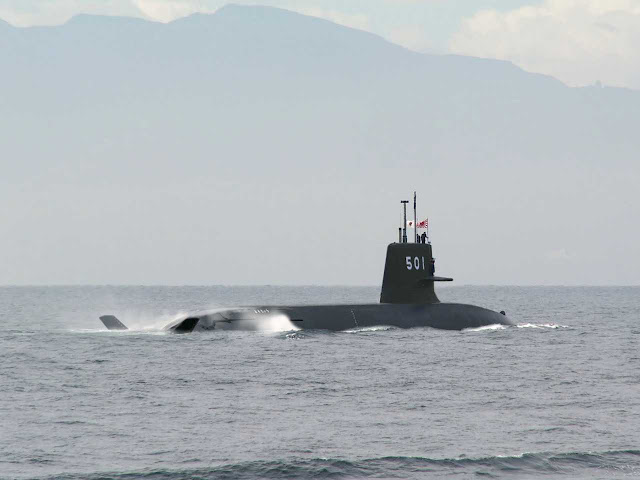Japan’s new ‘ninja’ submarines are all about stealth
Japan’s Soryu class submarines were launched by the Marine Self-Defense Forces (MSDF) in 2007, as an effort to increase the countries submarine force to a total of 22 (from the current 16) by the year 2024.
The submarine Hakuryu, or White Dragon, is the third of the class that is known for packing enough firepower to bring down an aircraft carrier. But according to the MSDF, the firepower is not the submarine’s best weapon – it is stealth.
“A submarine’s greatest weapon is stealth,” Maritime Self-Defense Force Capt. Kaoru Yoshida said. “Our mere presence that makes the enemy think ‘there might be a powerful submarine out there’ is a deterrent.”
The technology on the diesel-powered submarine allows it to stay submerged longer because it is able to generate energy by mixing fuel with liquid oxygen stored in tanks. Diesel-powered subs normally have to surface regularly to get ample supply of oxygen via an air tube. Since the Hakuryu and the other subs of this class surface far fewer times than other MSDF’s other submarines, they are more difficult to detect on radar and sonar.
Apart from that, the Hakuryu also packs a mean punch with its Type 89 torpedo, which has enough power to bring down a ship the size of an aircraft carrier. The National Defense Program Guidelines formulated at the end of last year stipulates an increase in the country’s submarine fleet, mostly to counter Chinese maritime aggression in the region, especially in areas around the Senkaku Islands claimed by both Japan and China in the East China Sea.
The stealth of the Hakuryu does comes at a cost, and it is the comfort of the crew that has been sacrificed. The Air-Independent Propulsion engine takes up an additional 10 meters of the length of the submarine’s central section than normal, making the crew’s living quarters very cramped for the 65 or so MSDF personnel who run the sub.
“It’s tough working in an enclosed space with limited water and air, but I’m motivated to take part in duties that only a few seamen can do,” Lt. Cmdr. Tomoharu Horiuchi, the Hakuryu’s 35-year-old chief engineer, said.
JPD
The submarine Hakuryu, or White Dragon, is the third of the class that is known for packing enough firepower to bring down an aircraft carrier. But according to the MSDF, the firepower is not the submarine’s best weapon – it is stealth.
“A submarine’s greatest weapon is stealth,” Maritime Self-Defense Force Capt. Kaoru Yoshida said. “Our mere presence that makes the enemy think ‘there might be a powerful submarine out there’ is a deterrent.”
The technology on the diesel-powered submarine allows it to stay submerged longer because it is able to generate energy by mixing fuel with liquid oxygen stored in tanks. Diesel-powered subs normally have to surface regularly to get ample supply of oxygen via an air tube. Since the Hakuryu and the other subs of this class surface far fewer times than other MSDF’s other submarines, they are more difficult to detect on radar and sonar.
Apart from that, the Hakuryu also packs a mean punch with its Type 89 torpedo, which has enough power to bring down a ship the size of an aircraft carrier. The National Defense Program Guidelines formulated at the end of last year stipulates an increase in the country’s submarine fleet, mostly to counter Chinese maritime aggression in the region, especially in areas around the Senkaku Islands claimed by both Japan and China in the East China Sea.
The stealth of the Hakuryu does comes at a cost, and it is the comfort of the crew that has been sacrificed. The Air-Independent Propulsion engine takes up an additional 10 meters of the length of the submarine’s central section than normal, making the crew’s living quarters very cramped for the 65 or so MSDF personnel who run the sub.
“It’s tough working in an enclosed space with limited water and air, but I’m motivated to take part in duties that only a few seamen can do,” Lt. Cmdr. Tomoharu Horiuchi, the Hakuryu’s 35-year-old chief engineer, said.
JPD

Comments
Post a Comment